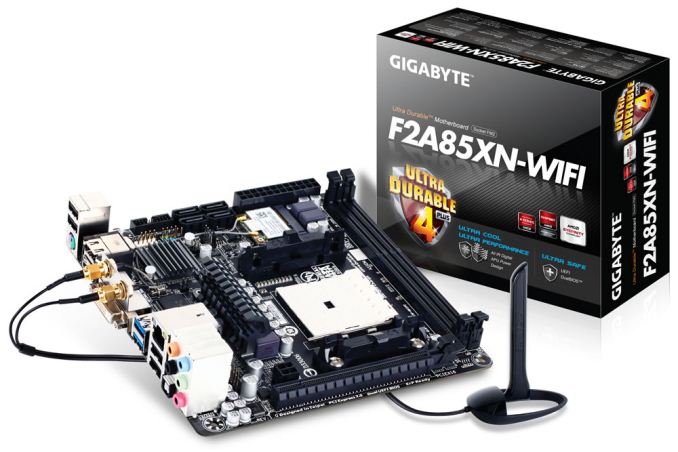GIGABYTE F2A85XN-WiFi Review: FM2 and Richland in mini-ITX
by Ian Cutress on August 21, 2013 10:00 AM ESTGIGABYTE F2A85XN-WiFi Conclusion
Building a mini-ITX FM2 based system results in less than a handful of choices when it comes to motherboards, all around a hundred dollars or less. At this price point, and for the size of the motherboard, each SKU available for sale comes with a different physical setup and as a user it means that it all depends on the setup you plan to have. GIGABYTE’s main selling point with the F2A85XN-WiFi is the dual band 802.11b/g/n WiFi itself, as well as using higher quality VRMs in their power delivery and AMD Wireless Display support.
Obviously when deciding on FM2, one of the big selling points of the platform is the integrated graphics, meaning users going along a discrete GPU path will end up not using that IGP, unless a non-IGP CPU is used (Athlon X4 760K). This is where mini-ITX comes in, as it reduces the extra GPU space that comes with an ATX or mATX size. There is a small reduction in other features as well that comes with the size – for example we have only four of the eight SATA 6 Gbps that the A85X chipset affords.
GIGABYTE’s other main selling point is also the use of two HDMI ports on the rear IO, suitable for multi-monitor on the IGP. For the BIOS and software, while we have the older classic mode and EasyTune6, users of other GIGABYTE motherboards should be familiar with these setups. Should GIGABYTE decide to release a mini-ITX FM2+ model alongside their current A88X announcement, I would hope the new EasyTune this would be part of the equation.
The F2A85XN-WiFi sits vicariously on the edge of Kaveri, with FM2+ motherboards and APUs expected sometime Q4 2013/Q1 2014. However if a user needs an AMD APU based A85X WiFi motherboard for a small build, GIGABYTE’s overclock performance on the F2A85XN-WiFi offers a promising solution.











31 Comments
View All Comments
IanCutress - Wednesday, August 21, 2013 - link
The motherboard manufacturer has options when deciding which digital display outputs are put on the motherboard itself. Typically we see HDMI, DP and DVI-D, though as I mention in comparison to other motherboards, some manufacturers can switch up the DP to a HDMI like this motherboard here. Other manufacturers will only use two digital displays (HDMI/DVI-D or DP/HDMI) and take the VGA from the chipset. I've never used a DP monitor in my personal life (I used DP for the 4K article), so I guess I would prefer multiple HDMI ports to rig up a couple of 1080p monitors. Manufacturers have an option of a DVI-I (combined DVI-D and VGA), although few actually do so.I happen to be working with a mini-ITX motherboard that goes along all three digital displays (HDMI/DP) with the combination DVI-I right now :)
Ian
geok1ng - Wednesday, August 21, 2013 - link
Please clarify me this point: you mean this mobo can run 3 monitors using cheap HDMI>DVI adapters at the same time, for example, in stock market/online poker?DanNeely - Wednesday, August 21, 2013 - link
AFAIK AMD hasn't made any GPUs (discrete or integrated) that have 3 legacy (VGA/DVi/HDMI) clock generators; as a result you'd need an active adapter. Intel's the same; with only some of nVidia's higher end cards supporting 3 non-DP displays.thatbox - Wednesday, August 21, 2013 - link
My Radeon 5770 does that, if that counts as AMD.DanNeely - Friday, August 23, 2013 - link
AFAIK all of those cards just put the active displayport to HDMI/etc converter on the card instead of requiring you to buy a dongle. The CPU chip itself is still limited to two legacy outputs.thatbox - Wednesday, August 21, 2013 - link
Had to check to see how everything was plugged in. None of my monitors has DP (the most recent one was made in 2006). One CRT (1920x1440x75Hz) using the DVI output with a VGA adapter, one LCD (1280x1024x60Hz) using the DP output with a DVI adapter, and one LCD (1920x1200x60Hz) using the HDMI output with a DVI adapter. I guess maybe the DP>DVI adapter could be active, if it can be active without being powered, but two a year and a half ago it was like twenty bucks as opposed to the sixty or seventy or more most others were and everything works fine. It was not a big a deal as the scary research I'd done suggested it would be.paperwastage - Thursday, August 22, 2013 - link
only the active DP->dual-link DVI is expensive(>$60) and typically needs a power source (via USB)the active DP->single-link DVI has been around $20-$30 for the past few years now, don't need power source. I remember getting mine for $30 in 2010
paperwastage - Thursday, August 22, 2013 - link
AMD itself hasn't made any reference design for 3 legacy clock, but it's partners have (though the demand is weak)eg: Sapphire Flex - see only 2 "in-stock" versions on newegg
http://www.sapphiretech.com/Flex/FleX_Eng_apply.ht...
GonzaloMin - Wednesday, August 21, 2013 - link
Love my job, since I've been bringing in $82h… I sit at home, music playing while I work in front of my new iMac that I got now that I'm making it online. (Home more information)http://goo.gl/UDMcRU
meacupla - Wednesday, August 21, 2013 - link
dual HDMI is probably for HDMI TV and HDMI receiver.not that DVI or DP can't be converted to HDMI, at extra hassle for the end user, so DP would be nice.